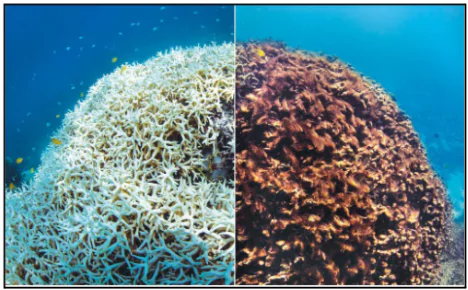Recently an “unprecedented” mass bleaching event has been recorded at Ningaloo Reef off Australia’s west coast.
Key Concerns Raised
- Extensive Coral Damage: Bleaching has impacted many coral species across deep and shallow reef areas.
- Temperature Surges: Ocean waters in Western Australia have been up to 3°C warmer than average over recent months.
Ningaloo Reef
- Ningaloo Reef is located just off the shore of Coral Bay on the west coast of Australia.
- Ningaloo Reef is one of the largest “fringing reefs” in the world.
- It is not part of the Great Barrier Reef.
|
- Potential Long-Term Effects: While bleaching does not mean immediate coral death, prolonged stress can cause mass mortality.
- Global Coral Bleaching Events: Documented by National Oceanic and Atmospheric Administration (NOAA) in 1998, 2010, 2014-2017, and 2023-2024 as the fourth global mass bleaching event.
- Scientists warn this may be the worst bleaching event since 2011.
About Corals
- Coral Polyps: Corals consist of genetically identical polyps that form large reef structures.
- Zooxanthellae Algae: These unicellular algae live within coral tissues, providing nutrients through photosynthesis.
- Types of Corals:
-
- Hard Corals (Stony Corals): Build reefs by extracting calcium carbonate from seawater.
- Soft Corals: Do not form reefs but attach to existing coral structures.
Ecological Importance
- Support 25% of marine biodiversity, including fish, crustaceans, and mollusks.
- Act as natural coastal barriers, protecting shorelines from erosion and storm surges.
- Contribute to fishing and tourism industries, benefiting global economies.
About Coral Bleaching

- When corals are stressed by changes in conditions such as temperature, light, or nutrients, they expel the symbiotic algae (zooxanthellae) living in their tissues, causing them to turn completely white.
- This is called coral bleaching.
- Reversibility: If temperatures stabilize quickly, corals can recover by regaining zooxanthellae.
Reasons for Coral Bleaching
Climate-Related Factors
- Rising Sea Temperatures: Global warming has caused SSTs to rise by 1°C in the last century.
- Marine Heatwaves: Rapid temperature increases trigger bleaching (e.g., 2020 event in the Gulf of Mannar, India).
- El Niño Events: Cause localized warming, worsening bleaching conditions.
Other Contributing Factors
- Sedimentation: Coastal development and bottom trawling deposit sediments that block sunlight, hindering coral photosynthesis.
- Ocean Acidification: As carbon dioxide levels rise, oceans take in more of it, leading to increased acidity in the water.
- This heightened acidity hampers corals’ ability to form the calcareous skeletons they rely on for survival
- Biological Invasions: Invasive species like crown-of-thorns starfish and algae outcompete bleached corals.
- Chemical Pollution: Exposure to oil, herbicides, and heavy metals can kill zooxanthellae.
- Pathogen Attacks: Some coral diseases strip coral tissues, leaving behind a bare skeleton.
Impact of Coral Bleaching
- Loss of Marine Biodiversity: Coral-dependent species face habitat destruction.
- Decline in Fisheries: Affected reefs reduce fish stocks, harming livelihoods.
- Increased Coastal Erosion: Dead reefs can no longer protect shorelines.
- Economic Losses: Coral tourism and fisheries face major revenue declines.
Global Efforts to Conserve Coral Reefs
- International Coral Reef Initiative (ICRI): A global partnership to protect reefs, with India as a member.
- World Coral Conservatory Project: Establishing coral banks in European aquariums to aid reef restoration.
- Biorock Technology: Uses electric currents to stimulate coral growth (e.g., Gulf of Kachchh, India).
- Super Corals: Breeding heat-resistant coral strains to withstand rising temperatures.
Indian Government Initiatives for Coral Conservation
- Coral Transplantation Projects:
-
- Gulf of Mannar Biosphere Reserve: Uses artificial reef structures to restore damaged reefs.
- Lakshadweep and Andaman & Nicobar Islands: Coral gardening projects underway.
- National Coastal Mission: Aims to protect marine ecosystems, including coral reefs.
- Regulations on Coastal Development: Stricter policies to prevent habitat destruction.
- Marine Protected Areas (MPAs): Several MPAs safeguard coral ecosystems from overfishing and pollution.
Conclusion
Urgent action is needed to address climate change and human-induced stressors to protect coral reefs. Strengthening global and national conservation efforts can help sustain marine biodiversity and coastal economies.
![]() 28 Mar 2025
28 Mar 2025


